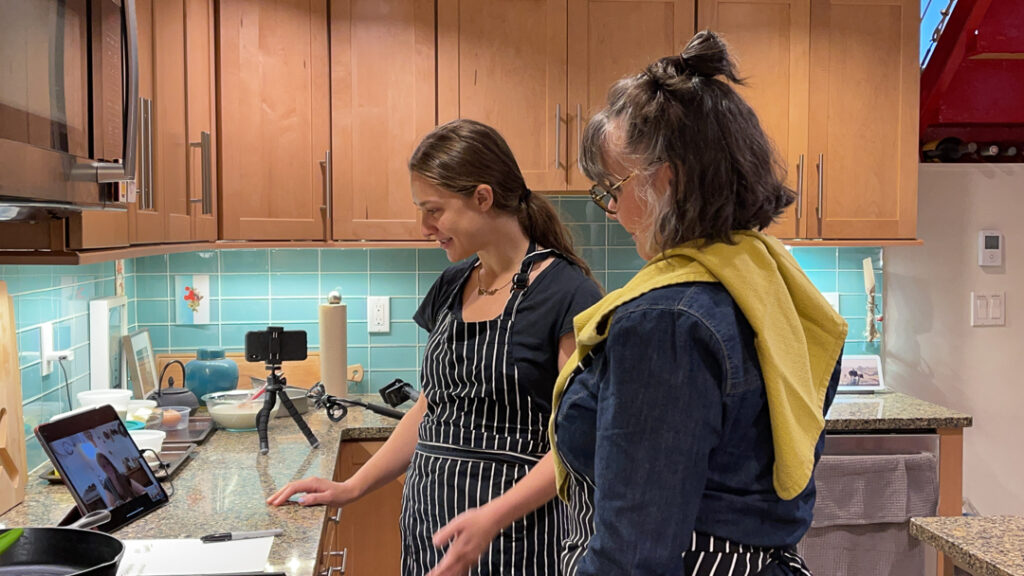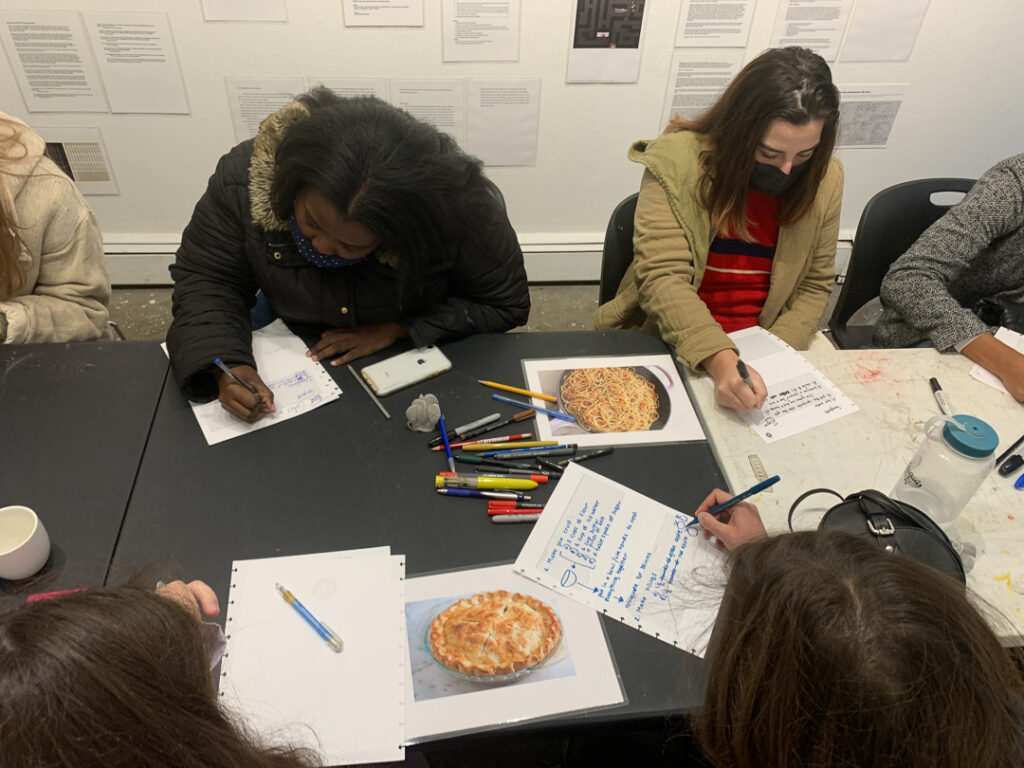Victoria Manganiello tells us about a social change project that invites artists to apply their creativity to making recipes for a better world.
You Stir the Pot is an anthology of recipes by artists from across the world. It combines cooking instructions with ways of making social change. The recipes link techniques like fermentation and marinating with the organising processes such as protesting, educating and donating. Garland editor Kevin Murray asks the project’s founder Victoria Manganiello about the origins of the project and how it works.
✿
Kevin Murray: As a textile artist, how did you develop an interest in cooking as a creative practice?
My work is inspired by where textiles intersect with other aspects of our culture and industries. For example, I work with technology (literally in using e-textiles, conductive thread and physical computing and conceptually, in exploring the history of the internet and the computer). Food and cooking have long been a source of inspiration for me in my creative practice and previous projects including Mordant and Fermentation Quilt were born from investigations into the ways that textiles play a role in the time we spend in the kitchen. I believe textiles are systems that facilitate connections between various parts of our daily lives and societies. Everyone has a personal connection to textiles whether that’s simply because they wear clothes and use things like towels and rugs daily or because, perhaps, their family and cultural heritage has a strong history of creating cloth in a special way. Somehow, I think both are true for most everyone.
I love to cook and food is probably one of life’s greatest joys for me. It’s often the premise for time spent with friends or family. And cooking is a way that I can relax and regroup after work or stress. When the global pandemic began, I started to cook more and it became a necessary and valued place for relief during such a stressful time. Early 2020 was also the time of much social action. And while this is nothing new – history has, of course, never been without resistance and activism – it was new in the sense that many more of us were participating from home. In my case, from the kitchen.
KM: In what ways can recipes be an agent of social change?
Art, many agree, is a place and a way for people of varying backgrounds and persuasions to find common ground. Access to beauty can equalize us and the chance to engage with something that physically embodies a person’s lived experience can be incredibly powerful. Food functions similarly and, as far as I can tell, this is true across cultures. When a cook or a chef prepares something with care and attention to detail, you can feel it. Even if it’s subtle and usually unnoticed, we can send messages with food. An invitation to a meal is a gesture of hospitality, commitment or affection from host to guest. Particular dishes and ingredients correspond to cultural celebrations or festivals inspired by location and ritualized over time. And the acceptance, refusal or speed, sound and manner with which we eat can signal a variety of things. While food is a communication tool largely untapped by those who are trying to communicate, there are many precedents and frameworks to work with. And so, perhaps recipes can be an agent of social change as both a format (an abstraction of a community guideline or the like) but also because they inspire us to make, they can inspire us to cook, to eat, to gather. Moreover, though, “You Stir the Pot: Recipes for Change” is really inspired by a history of people – often those restricted to home, domestic spaces – using food as a way to speak up.
I’ve engaged with this metaphor as a “student”. What initially motivated this project was research by people like Lauren Fournier and Ashley Jane Lewis (you can find a growing reading list on the project’s website, here) who consider this conversation in really interesting and inspiring ways. I’m certainly not inventing the concept, simply organizing another place for people to engage with it.
M: What relationship do you see between the recipes and the other creative work done by the participants?
The recipes in this project are made by artists around the world and anyone who wants to contribute one, may. While the first edition of the book will print recipes from the first 37 artists’, I intend to continue producing future editions. Additionally, all will be available on our website.
As this project started abstractly, most of the recipes collected so far come from friends or people in my own extended networks. While there are a lot of textile artists represented — this is, of course, my own community — people working across mediums including wood, glass, paper, video, writing and others have contributed. I would say that the common thread is perhaps our shared interests in collaboration and storytelling. Many of these artists use food as a major aspect of their practices while others have not worked with it outside their homelife.
Since we started the project, there have been a few opportunities for participants to work together in various ways. We conducted workshops and an exhibition in NYC thanks to AIR Gallery and Civic Art Lab and in Zurich, Switzerland thanks to TaDA, Volumes and Maya Minder. We have also gathered virtually and in-person. For example, Winnie van der Rijn (USA) and Marlene Herberth (Romania) prepared a recipe from Marlene’s grandmother’s recipe book together, over zoom. Two groups of us enjoyed the cake simultaneously, across the globe. Also, the project started during a 2019 residency hosted by the National Taiwan Craft Research and Development Institute and organized by Tribe Against Machine based in Taipei. I hope we put together more events and actions to celebrate and also, to organize. I also hope that this growing project and the open prompt motivate more artists to contribute something. As the collection grows, it will be curious to see what other commonalities present themselves.
KM: Can you give an example of a recipe and how it can stimulate social change?
Speaking generally, food can be used to bring people together and build community, which can lead to social change. When people share a meal together, they have the opportunity to connect and learn from one another, and this can create a sense of solidarity and a desire to collaborate to make positive change in the world in potentially any area of need.
Food can be a powerful way to tell stories and share experiences, and this can inspire social action by helping people to understand and empathize with others who may be facing different challenges or living in different circumstances. And, it can also be used to raise awareness with popular, food-related events or campaigns used to educate people about hunger and food insecurity, or to advocate for policies that support sustainable agriculture or fair labor practices in the food industry, for example.
“You Stir the Pot: Recipes for Change” is a collection of examples that are intended to stimulate social change and the variety of experiences and perspectives of the authors provides us with insights and approaches of many vantage points.
For example, in their recipe “ nao tang,” Zito Tseng describes the history of brainwashing in China alongside instructions for preparing and cooking a brain for, presumably, eating. While brainwashing is, as a term itself, a metaphor, Zito offers us the chance to do it literally. While I have not yet myself followed the recipe, simply reading it and imagining the process of opening a skull, removing a blood-brain barrier, boiling and eventually seasoning is an incredibly visceral experience. Taking this familiar term “brainwashing” and making it literal forces me to take seriously in a new way, the pervasive approach governments or other groups with power take to control people.

Another example is Jamie Boyle’s “Sauerkraut: After the Fermentation, Bake a Cake!” which walks us through the process of making fermented cabbage. Her language is chosen carefully though and the entire process of nurturing bacteria with patience and attention to detail is described in such a way that one could understand to be wise when organizing a collective action. Jamie uses words like “thrive” to describe the ideal outcome for a bacteria when fermenting and so we may also imagine a community that is thriving under the circumstances that work for them and their specific needs. As community organizers, we must consider what the community we seek to support needs and in their own terms rather than what we ourselves might need. The same is true with fermentation whereby the air, water, pressure, etc. are going to vary depending on the specific bacteria. In Jamie’s recipe, the language itself is the agent of change and the recipe and the food are locations for them to exist and for us to encounter them.
Laura Splan’s recipe “Breads for Breaking” is AI, computer generated. By providing the computer with terms for what cooking can be and what social action can be, she was able to output this instruction. I invite everyone to read the abstract recipes in the collection closely, with attention to this detail. There is a lot to be discovered in the language. An approach, of course, honed by many covert communicators of the past.
KM: Besides this publication project, can you envisage other platforms for this nexus between food and social change, such as a restaurant or “progressive” dinners?
There are so many possibilities for food and social change to intersect and I see many artists (including those that inspired this project and those who are participating in it) doing that. Whitney Newton, for example, who contributed the recipe “ Cultural Hybrid Veggie Dumpling “ also co-organizes a project called Hot Pot Goods that uses art and food as education tools, donating all proceeds to food-related organizations in Chinatown, New York. I hope to see and engage with more projects like these myself and I hope that people can connect with like-minded makers through “You Stir the Pot: Recipes for Change” to organize new initiatives, together.
Food and nutrition are incredibly important on the global scale right now and environmental and sustainability concerns are bound to further increase challenges of those sorts. But more than the literal context for social change and food to overlap, I believe there are many possibilities for us to use the power of art and metaphor to touch other areas in need as well. Recipes in “You Stir the Pot: Recipes for Change ” touch on topics related to gender and sexuality, mental health, immigration, racism, sexism and labor rights. All of these important topics need our attention and if, perhaps, writing a recipe can be the way to reach a new person, then we have found success. There is an open invitation to anyone participating in “You Stir the Pot: Recipes for change” to facilitate their own engagement program under our community umbrella and I expect that if you follow along, you’ll hear more about many things that are currently “brewing.”
For more information, visit www.youstirthepot.com and follow @youstirthepot
About Victoria Manganiello
 Victoria Manganiello (Brooklyn, NY, USA) is an artist, designer, organizer, and educator. She has exhibited her work internationally including across Europe, Taiwan, Australia, and throughout the USA including at the Tang Museum, Museum of Art and Design, Ars Electronica, BOZAR, Indianapolis Museum of Contemporary Art, Australian Tapestry Workshop and the Queens Museum. She is also a part-time associate professor at NYU and the New School and co-organizes an annual artist residency for e-textile practitioners. She is well-known in the textile community as an accomplished artist and innovative storyteller and facilitates many socially engaged projects in collaboration with other artists, designers and educators. Visit www.victoriamanganiello.com and follow @victoriamanganiello
Victoria Manganiello (Brooklyn, NY, USA) is an artist, designer, organizer, and educator. She has exhibited her work internationally including across Europe, Taiwan, Australia, and throughout the USA including at the Tang Museum, Museum of Art and Design, Ars Electronica, BOZAR, Indianapolis Museum of Contemporary Art, Australian Tapestry Workshop and the Queens Museum. She is also a part-time associate professor at NYU and the New School and co-organizes an annual artist residency for e-textile practitioners. She is well-known in the textile community as an accomplished artist and innovative storyteller and facilitates many socially engaged projects in collaboration with other artists, designers and educators. Visit www.victoriamanganiello.com and follow @victoriamanganiello
Upcoming Group Exhibition at Australian Tapestry Workshop Thursday 9 March 2023 – Friday 12 May 2023;






